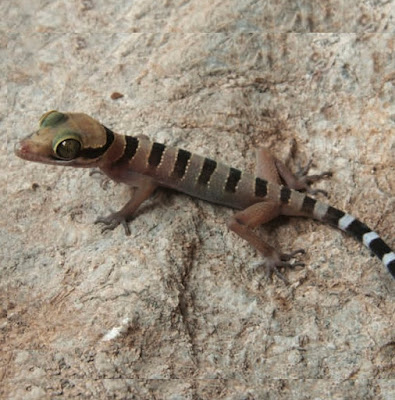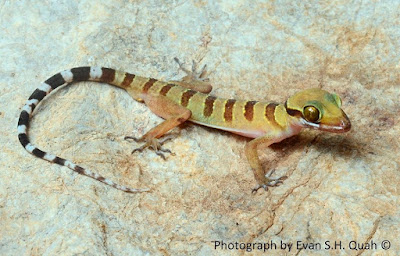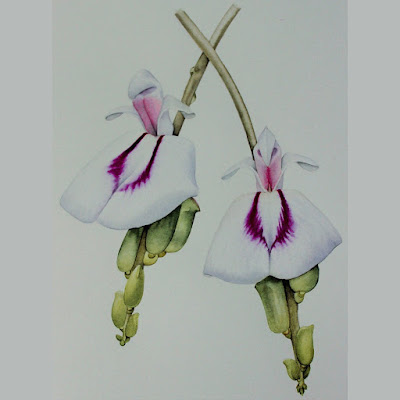[Most Recent Entries] [Calendar View]
Wednesday, March 18th, 2020
| Time | Event | ||||||
| 2:18a | [Herpetology • 2020] Cyrtodactylus evanquahi • A New Potentially Endangered Limestone-associated Bent-toed Gecko of the Cyrtodactylus pulchellus (Squamata: Gekkonidae) Complex from northern Peninsular Malaysia
Abstract A survey of a limestone forest at Gunung Baling, Kedah, West Malaysia lead to the discovery of an undescribed species of Bent-toed Gecko from the Cyrtodactylus pulchellus complex. Cyrtodactylus evanquahi sp. nov. can be distinguished from all other species in the C. pulchellus complex by a suite of morphological and color pattern characteristics: prominent tuberculation, higher number of dark body bands, and a smaller maximum SVL. It is further differentiated from all other species as follows; no tubercles on the ventral surface of the forelimbs, gular region, or in the ventrolateral folds; 31–34 paravetebral dorsal tubercles; 18–23 longitudinal rows of tubercles; 29–33 ventral scales; 22–23 subdigital lamellae on the fourth toe; 32–36 femoroprecloacal pores; a shallow precloacal groove in males; body bands and nuchal loop edged with a thin white line bearing tubercles; no scattered white spots on the dorsum; six or seven dark body bands much thinner than interspaces; 9–11 dark caudal bands on original tail; bands on the original tail separated by immaculate white caudal bands. It is further differentiated by an uncorrected pairwise genetic divergence of 6.50–15.67% from all other congeners in the C. pulchellus complex. It is most closely related to C. pulchellus from Penang Island ∼76 km to the southwest. In addition to the new samples from Gunung Baling, we added four samples of C. bintangrendah from the new locality of Belukar Semang, Perak. The discovery of yet another new species of the C. pulchellus complex from a limestone habitat continues to underscore the high degree of endemism and the importance of these unique habitats for biodiversity, and the continued need for their conservation. Keywords: Reptilia, Conservation, Gunung Baling, Karst, Kedah, ND2, new species, Southeast Asia
Cyrtodactylus evanquahi sp. nov. English: Evan Quah’s banded Bent-toed Gecko Malay: Cicak Jari-bengkok Evan Quah Etymology. The specific epithet honors Dr. Evan S. H. Quah, who suggested the urgency to document the herpetofaunal diversity of Gunung Baling, Kedah, which is under constant threat from two cement companies that are actively mining the limestone. He also participated in the only herpetological survey of the area. Dr. Quah is an extremely productive contributor to the study of herpetology in Malaysia and is a champion for conservation of the region. Perry L. Jr. Wood, L. Lee Grismer, Mohd Abdul Muin, Shahrul Anuar and Jamie R. Oaks. 2020. A New Potentially Endangered Limestone-associated Bent-toed Gecko of the Cyrtodactylus pulchellus (Squamata: Gekkonidae) Complex from northern Peninsular Malaysia. Zootaxa. 4751(3); 437–460. DOI: 10.11646/zootaxa.4751.3.2 | ||||||
| 2:48p | [Botany • 2018] Canavalia llanorum (Leguminosae, Papilionoideae) • A New Species of Canavalia subgenus Wenderothia from the Colombian and Venezuelan Llanos
Abstract Canavalia llanorum (subgenus Wenderothia) from the northwestern Llanos region of Colombia and Venezuela (Orinoquia) is described and illustrated, and its morphological relationship with an allied species is discussed. The new species is morphologically related to C. bicarinata, but it differs mainly by its legumes having only one extra medium rib (vs. two ribs in C. bicarinata), and by its leaflets elliptic-ovate or obovate (vs. ovate). We also discuss the phylogenetic position of C. llanorum and present geographical and ecological information about the new species.
Canavalia llanorum Snak, Aymard & L. P. Queiroz, sp. nov. Etymology.—The specific epithet llanorum refers to the geographical distribution of the new species in the Llanos region of Colombia and Venezuela. Cristiane Snak, Gerardo A. Aymard C. and Luciano Paganucci de Queiroz. 2018. A New Species of Canavalia (Leguminosae, Papilionoideae) subgenus Wenderothia from the Colombian and Venezuelan Llanos. Brittonia. 70(2); 233–240. DOI: 10.1007/s12228-017-9512-2 Resumen: Canavalia llanorum (subgénero Wenderothia) de la región Noroeste de los Llanos de Colombia y Venezuela (Orinoquia), es descrita, ilustrada y sus relaciones morfológicas con su especie afín son discutidas. Esta nueva especie presenta similitudes con C. bicarinata, sin embargo, difiere por la legumbre con una sola costilla en el medio (vs. dos costillas en C. bicarinata) y por los folíolos elípticos-ovados hasta obovados (vs. ovados). Se discute la posición sistemática de C. llanorum basada en análisis filogenéticos, y se presenta información acerca de la distribución y ecología de la nueva especie. |
| << Previous Day |
2020/03/18 [Calendar] |
Next Day >> |





